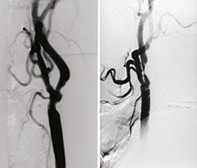Peer Reviewed
Feature Article Stroke
Stroke-prone patients: focus on carotid surgery and stenting
Abstract
Carotid endarterectomy effectively reduces the risk of stroke. Will carotid artery stenting prove to be as effective, and any safer?
Key Points
- Transient cerebral symptoms and neck bruits are the key warnings of immediate stroke risk. A TIA is a cerebral emergency – start aspirin, and investigate promptly.
- Although atheroembolism from unstable carotid plaques is a frequent cause of stroke, carotid stenosis guides patient selection for surgical intervention.
- In the last decade, imaging of carotid disease by duplex ultrasound studies and angiography has improved in detail and safety.
- Carotid endarterectomy provides evidence-based stroke prevention in selected patients.
- Carotid artery stenting is a percutaneous alternative to open operation but is on trial; currently, its efficacy is unproven and it carries significant risks.
- Modern stroke prevention combines surgical intervention (both open and endovascular carotid surgery) with the medical management of multiple risk factors for stroke, such as hyperlipidaemia, hypertension and hyperviscosity.

